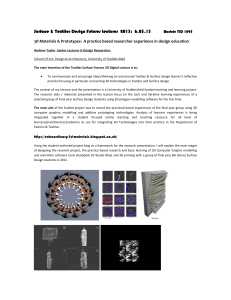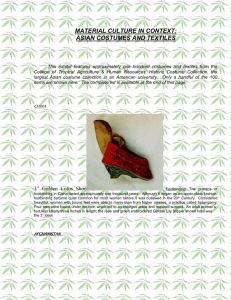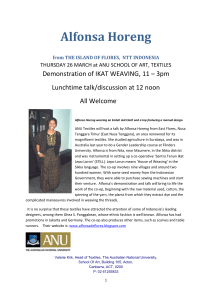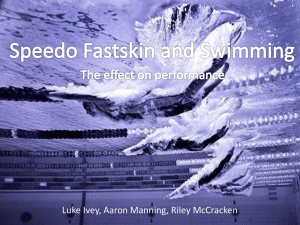Smart Materials revision
advertisement
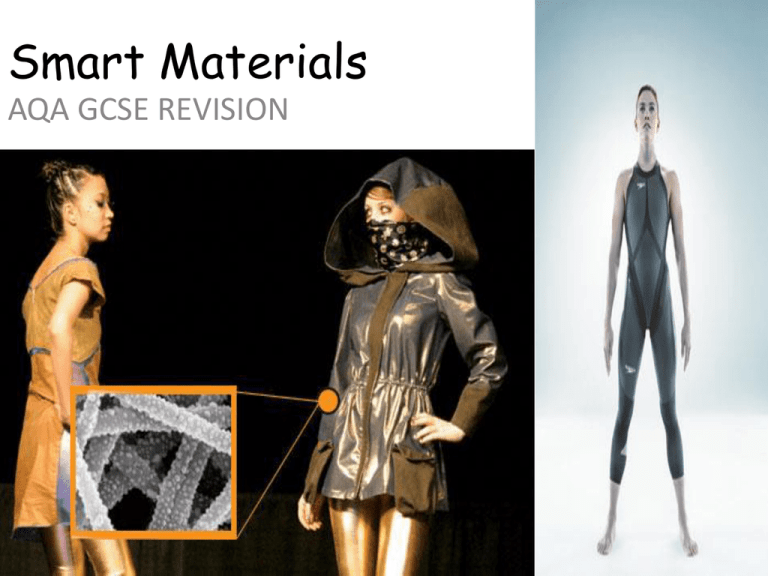
Smart Materials AQA GCSE REVISION Biomimetics These fabrics have been designed to mimic nature Speedo’s Fastskin® swimsuit was developed using V-shaped fibres which mimic the ridges found on the skin of a shark Stomatex® is a lightweight, strong & flexible material that mimics transpiration in plants. Modern Textiles From Bathing to Swimming to Where next? Swim wear to this day is made using the warp knitting method of construction. Unlike Latex Lycra does not loose its elasticity when washed. BIOMIMETICS Michael Phelps won 8 Gold medals in the 2008 Olympics in Beijing wearing a Speedo Fastskin swimsuit, designed to mirror the efficiency of shark skin. The Fastskin swimsuit is inspired in the shape and texture of shark skin. Shark skin's texture varies to adapt to water flows and currents against its body, in order to navigate in the most efficient manner. Modern Textiles BIOMIMETICS Modern Textiles Patagonia environmentally benign wetsuits. The neoprene outer is of 80% non-petroleum based ingredients. (Fortune Mag reckoned it was made with crushed limestone but the Patagonia site is coy on that aspect.) The inner lining is a chloridefree merino wool grid bonded to recycled polyester. Kneepads are PVC-free and are said to be more durable and grippier. Coming for both men and women in 2mm and 3mm versions, to span water temps from 48 to 65°F (9 to 18°C). Long and shortie styles, although limited availability just now. ::Patagonia Wetsuits. BIO-RUBBER MATERIALS. Modern Textiles Using materials like "Bio Stretch" rubber and "Eco Flex" exterior, Body Glove has created the "first environmentally friendly wetsuit." While the folks at Patagonia might have something to say about that, Body Glove's "Eco Wetsuit" can boast 100% petroleum-free materials which consume "1/10th the amount of energy normally used in the manufacturing of standard petroleum based wetsuits." As we've noted before, surfing and TreeHugging go together like fair trade chocolate and organic peanut butter; it's good to see more ways to walk the walk (and, hey, if you can look as bad-ass as this guy, why not?) before paddling out for some tasty waves. Get all the details about the Eco Wetsuit at ::Body Glove via ::Core77 Modern Textiles NEOPRENE Polyurethane Jack O'Neill Jack is the creator of the wetsuit back in the early 50's. Jack first came across a fabric now widely known in the surf world as neoprene. Strangely enough he discovered it on the floor of an aeroplane! He ordered masses of the material and started stitching it together to make vests, and later suits. In 1952 Jack opened his first surf shop in San Francisco, California, and appropriately called it 'Surf Shop'. Speedo The full-bodied Fastskin FSII Ice suits 2006 • Fastkskin FS II are textured with bumps and ridges in key places, similar to those on a shark's skin. These ridges serve to channel the water over the swimmers body in a more efficient manner than traditional material suits.[27] In addition, the suits are custom designed for the type of strokethe swimmer will use as well as being engineered differently for women and for men. These high-tech suits make use of elastic compression materials to limit muscle oscillation and to compress the swimmer's body, while in other areas a more flexible fabric is used to allow greater range of motion. Speedo LZR Racer - 2008 NASA computer image used in development of the Speedo LZR Racer • • Perhaps the company's most controversial move came with 2008's unveiling of the LZR (pronounced "lazer") Racer — a suit, as Speedo's website boasts, "so fast, it was banned from competition".[36] Indeed the LZR Racer was banned by FINA in 2009, but not until swimmers wearing this suit had already broken at least 46 world records.[37] The super smooth suit, which was optimized with the help of NASA wind tunnels, uses welded seams and multiple woven fabrics to reduce drag by up to six percent.[27] In addition, the LZR, like the Fastskin, utilizes a core stabilizer, which acts almost as a girdle, to reduce muscle movement. This is designed to help the swimmer maintain the proper angle in the water for longer periods of time.[27][37] Popular Science magazine named this suit to their "100 Best of What's New '08" list, calling it "The fastest swimsuit in the world".[38] FINA's ban on the LZR Racer and all "hitech" suits BBC Technical textiles and Shark skin swimsuit • http://www.tes.co.uk/mypublicprofile.aspx?uc =2186673 • http://www.tes.co.uk/mypublicprofile.aspx?uc =2186673 Smart Textiles Smart textiles can sense, react & adapt to the conditions around them. For example, they can react to: • Hot or cold temperature Uses Novelty clothing • Light Protective clothing • Pressure Safety equipment • Moisture Medical textiles • Time Some smart materials meet a real need & have been developed for specific functions. Others are more of a novelty design feature. Military uses Anti-allergen products Baby products Pressure response Fabric D3o is a new innovation It is a soft malleable material most of the time, but when it comes into contact with force, it hardens on impact http://www.youtube.com/watch?v= tKQxDoXqc_I Memory Foam is temperature & pressure sensitive foam that moulds to the shape of the body & returns to normal when pressure is removed. Micro-encapsulation Chemicals / Fragrances are captured in microscopic polymer bubbles which are added to natural or microfibres. When the fabric is rubbed or comes into contact with the skin, the bubbles slowly burst to release their content Thermochromic Colour Thermochromic textiles change colour with heat. They are engineered to change colour at a particular temperature. There are serious medical uses as well as novelty ones, e.g. liquid crystal fabric strip thermometers, & baby sleep-suits to monitor temperature. Photo chromic dyes Photo chromic dyes react to UV light & change colour. They can be useful for monitoring the amount of time children spend in the sun, to prevent sun-burn. Photo chromic dyes What conditions will activate a smart fabric? Light (UV exposure) Photochromic paints and dyes change colour when exposed to light. They are used for summer garments to indicate the strength of UV rays – especially good for children’s clothes. Pigment changes in the sun and is used for T shirt design Phosphorescent Pigments These dyes are used in glow-in-the dark products. Interactive or Electronic Textiles An interactive fabric incorporates electronics that are activated by a power source. They are still Smart fabrics, they just require a power source. Interactive or Electronic Textiles Examples of Interactive fabrics 1. The Life Shirt, which monitors blood pressure. 2. Garments with builtin mobile/mp3 technology. 3. Heated gloves. 4. Tracksuits which can monitor performance. 5. Products which emit light and/or sounds. Some more Electronic Fabrics Graphic Equilizer T-shirt playing to Lady GaGa http://www.youtube.com/watch?v=uGv6Bw34PtU Electronic fashion on the catwalk – by Diana Eng http://www.youtube.com/watch?v=BkdJv5OCXio&feature=related The climate dress http://www.youtube.com/watch?v=bgVaUqSK3IQ Wearable Tech/Smart clothing video from BBC i Player http://news.bbc.co.uk/1/hi/programmes/click_online/9699488.stm

